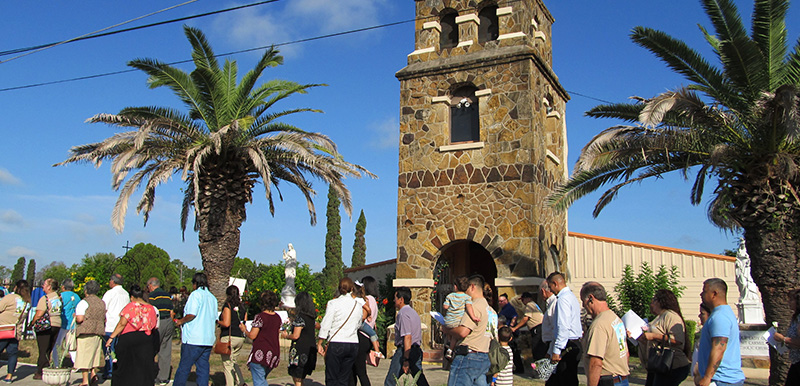[vc_row css=”.vc_custom_1454688891884{padding-left: 13% !important;}”][vc_column][vc_empty_space][vc_gallery type=”flexslider_slide” interval=”3″ images=”6253,6254,6255,6256,6257,6258,6259,6260,6261,6262″ img_size=”full”][vc_empty_space][vc_column_text]
El Carmen Parish celebrates 200 years
By Carol Baass Sowa
Today’s Catholic
SAN ANTONIO • When Our Lady of Mount Carmel Parish in Losoya, known as El Carmen, celebrated its 200th anniversary, it took two weekends to properly commemorate the significant occasion. Its church was originally a chapel built in 1817 to mark the mass grave of Spanish royalist soldiers who died in the bloody 1813 Battle of Medina nearby, a forerunner of Texas’ 1836 struggle for independence.
Archbishop Gustavo García-Siller, MSpS, celebrated Mass and initiated a parish novena in the present church on June 9, followed by a luncheon in the church hall where an extensive collection of pictures, documents and articles on El Carmen’s history was displayed.
This exhibit was present the following weekend on June 15, when hundreds turned out for the opening procession in which a statue of Our Lady of Mount Carmel was carried by members of the Knights of Columbus through the old cemetery adjacent to the church. Here, founders of the parish and deceased family members were remembered and flowers ceremonially placed on the graves of priests and nuns who had served this humble rural community over the years. Matachines dancers participated in this.
Singing songs led by the parish choir, accompanied by mariachi-style musicians, the procession ended in the church hall where flowers and crowns were placed before the statue of Our Lady of Mount Carmel holding the infant Jesus. A rosary was recited, after which Father José Francisco Puente Flores, pastor, presided over Mass in the hall. His homily touched on Biblical stories related to Mount Carmel in the Holy Land, the Carmelite order and the bestowing of the brown scapular by Our Lady on St. Simon. He concluded with the observation that Our Lady of Mount Carmel is an antidote for today’s “culture of death.”
During the luncheon that followed, attendees were enlightened by author/historian Art Martínez de Vara on the history of El Carmen, whose founding had roots in Napoleon’s victory over Spain, which governed Mexico. The subsequent uprising of Mexican indigenous and commoners, led by Father Miguel Hidalgo, resulted in his execution, but the taking of San Antonio by the rebel Republican Army of the North, who executed royalist leaders there. This led to the Battle of Medina, where royalist victors retaliated with harsh treatment of recaptured San Antonio. Daily, three men were beheaded in the plaza and three women publicly stripped and whipped.
This traumatic experience, said Martinez, set the stage for why some here supported the later revolution, while others fled. “The generation that participated in the 1836 uprising,” he noted, “were children in this 1813 uprising and had witnessed the atrocities of the Spanish.” His book, El Carmen: The Chapel of the Battle of Medina, first volume in the Northwest Vista College Series in Texas History, details more of this era, the church and Villa del Carmen’s rich Catholic history.
Special guests in attendance included sisters of the Daughters of Charity who staffed the medical clinic at El Carmen, descendants of early parishioners, a representative from St. Leo the Great, which once missioned El Carmen, area historians and community leaders.[/vc_column_text][/vc_column][/vc_row][vc_row][vc_column][/vc_column][/vc_row][vc_row css=”.vc_custom_1454689006235{padding-top: 20px !important;padding-bottom: 45px !important;padding-left: 13% !important;}”][/vc_row]


